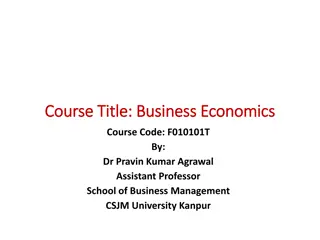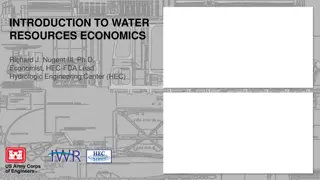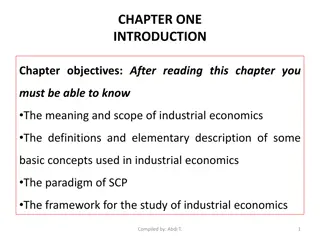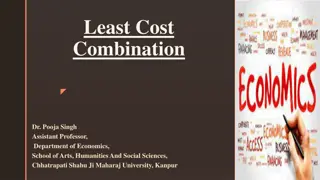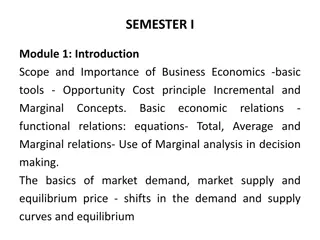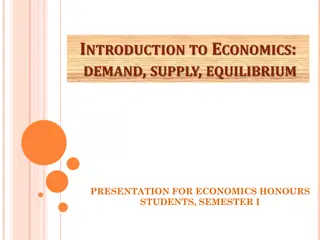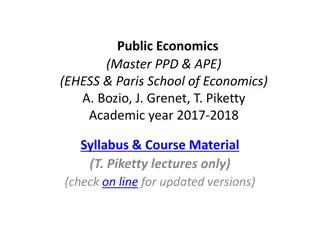
Demand in Economics: Effective Demand, Demand vs. Quantity Demanded
Explore the concept of demand in economics, including effective demand, demand vs. quantity demanded, demand schedule, and the relationship between price and quantity demanded. Learn how to differentiate between demand and quantity demanded through real-world examples.
Download Presentation

Please find below an Image/Link to download the presentation.
The content on the website is provided AS IS for your information and personal use only. It may not be sold, licensed, or shared on other websites without obtaining consent from the author. If you encounter any issues during the download, it is possible that the publisher has removed the file from their server.
You are allowed to download the files provided on this website for personal or commercial use, subject to the condition that they are used lawfully. All files are the property of their respective owners.
The content on the website is provided AS IS for your information and personal use only. It may not be sold, licensed, or shared on other websites without obtaining consent from the author.
E N D
Presentation Transcript
Demand - Meaning Demand in Economics implies effective demand Effective demand consists of: a) Desire or want for a commodity or service b) Ability to pay for that good or service c) Willingness to part with a certain proportion of one s income.
Thus, Effective demand = Desire + Ability to pay+ Willingness to pay. Demand is defined as the various quantities of a given commodity or service which consumers would buy at various prices during a given period of time . Demand is always related to price at a particular time.
Demand and Quantity demanded difference. It is extremely important to understand the difference between demand and quantity demanded. Demand refers to the entire relationship between prices and the quantity of this product or service that people want at each of these prices should be thought of as "the demand curve." Quantity demanded refers to one particular point on the demand curve (not the entire curve). refers to how much of the product is demanded at one particular price. is the horizontal distance between the vertical axis and the demand curve.
A Demand Schedule. When the relationships between quantity demanded of a commodity and [prices are tabulated, it is called as demand schedule. It is a table or chart which shows the quantities of a commodity demanded at different prices during a given period of time.
A demand schedule Price of Coffee (per $) Quantity of coffeecups 1 20 2 16 3 12 4 08 5 04
The demand schedule refers to the quantity of coffee cups demanded by an individual at different prices. We observe that as the 4 price of each coffee cup goes on rising, the quantity demanded each time goes on falling. This indicates the inverse relationship between price and quantity demanded.
Diagrammatically, we plot the points on a graph. The vertical (Y axis) denotes the price of coffee cups in dollars. The horizontal axis (X axis) denotes the quantity of coffee cups demanded at each price. Each point on the graph corresponds to a particular price and quantity demand.
As we join the points on the graph, we observe that the curve slopes from left to right. Thus the curve has a negative slope. This indicates a trade off between price and quantity demanded. As price rises, demand falls and vice versa. When quantity demanded for coffee cups by all consumers is summed up, we get the market demand curve (for coffee cups).
The position of the demand curve will shift to the left or right following a change in an underlying determinantof demand. Increases in demand Increases in demand are shown by a shift to the right in the demand curve. This could be caused by a number of factors, including a rise in income, a rise in the price of a substitute or a fall in the price of a complement, effective sales and advertising campaigns and so on Decreases in demand Conversely, demand can decrease and cause a shift to the left of the demand curve for a number of reasons, including a fall in income assuming a good is a normal good, a fall in the price of a substitute and a rise in the price of a complement, reduced advertising, fall in population and so on.
The Law of Demand The functional relationship between price and quantity demanded of a commodity is explained by the law of demand. The law is also known as the first law of purchase . According to Alfred Marshall Other things being equal if the price of a commodity falls, the quantity demand of it will raise and if the price of the commodity rises, its quantity demanded will decline .
Factors influencing Individual demand Price of a commodity: It is the primary determinant of demand. At higher prices, an individual will purchase less of a commodity and vice versa. This indicates an inverse relationship of price with demand. Price of related goods: a. Substitute goods (those that can be used to replace each other): price of substitute and demand for the other good are directly related. Example: If the price of coffee rises, the demand for tea should increase. b. Complement goods (those that can be used together): price of complement and demand for the other good are inversely related Example: if the price of ice cream rises, the demand for ice-cream toppings will decrease.
Income: A rise in a persons income will lead to an increase in demand (shift demand curve to the right), a fall will lead to a decrease in demand for normal goods. Goods whose demand varies inversely with income are called inferior goods. Consumer s tastes and Preferences: this is a subjective factor also influenced by social and cultural factors. If an individual is generally habituated to cigarettes, coffee or alcohol; due to his strong preferences for this products, his demand would remain high. Expectation of future: a. Future price: consumers current demand will increase if they expect higher future prices; their demand will decrease if they expect lower future prices.
b. Future income: consumers current demand will increase if they expect higher future income; their demand will decrease if they expect lower future income. Effect of advertisement: Advertisement campaigns significantly affect the demand for consumer durables such as television sets, air conditioners, refrigerators and also certain items of daily use like sops, toothpaste, shampoos and so on. Higher and better the ad campaigns (including free/complementary items), higher the demand for them.
Factors influencing market demand. Changes in weather conditions : According to changes in weather the demand for certain goods will change. For eg. During the summer season, demand for cold drinks, air conditioners etc will be more and during winters, demand for woolen clothes will be more. Changes in fashion : The demand for a good will be more if it is in fashion (example, the bellbottom pants were in fashion in the 70s and hence their demand was more.) Developing countries often emulate the dressing style, eating habits of developed countries. This is called as the demonstration effect. Changes in money circulation : The central government may decide to relax its monetary policy (and increase its money supply) increasing the purchasing power of people which in turn would lead to increase in demand.
Number of Buyers and size of the market: The more the buyers in the market , larger is the demand; fewer buyers lead to decrease. A large market, spread over a vast area ensures higher demand. Changes in the size of population : When the size of population increases the demand for various goods and services will go up and vice versa. Growth in population leads to higher demand for basic commodities like food, clothing and shelter and over a period of time, for comfort goods like television sets and cars. Technological changes: Better technology and innovations will lead to production of new goods and services which are more efficient. Hence the demand for new goods will increase. They will replace old goods and services.
Discovery of cheap substitutes : Availability of cheap substitutes will affect the demand for certain goods. For example, supply of cheaper polythene bags affect the demand for jute bags. The law of demand thus states an inverse relation between demand and price. However there are situations where the law does not hold eg: if people expect a shortage of goods in the future, they may purchase more even when the prices are high. Goods with inelastic demand are demanded even when prices are high example vegetables, salt etc.
Exceptions to the law of demand Exceptions to the law of demand The law of demand does not apply in every case and situation. The circumstances when the law of demand becomes ineffective are known as exceptions of the law. Some of these important exceptions are as under. Giffen Giffen goods: goods: Some special varieties of inferior goods are termed as Giffen goods. Cheaper varieties of this category like bajra, cheaper vegetable like potato come under this category. Sir Robert Giffen of Ireland first observed that people used to spend more their income on inferior goods like potato and less of their income on meat. But potatoes constitute their staple food. When the price of potato increased, after purchasing potato they did not have so many surpluses to buy meat. So the rise in price of potato compelled people to buy more potato and thus raised the demand for potato. This is against the law of demand. This is also known as Giffen paradox.
Conspicuous Consumption Conspicuous Consumption Goods of Snob Appeal: This exception to the law of demand is associated with the doctrine propounded by Thorsten Veblen. A few goods like diamonds etc are purchased by the rich and wealthy sections of the society. The prices of these goods are so high that they are beyond the reach of the common man. The higher the price of the diamond the higher the prestige value of it. So when price of these goods (also called as Veblen goods) falls, the consumers think that the prestige value of these goods comes down. So quantity demanded of these goods falls with fall in their price. So the law of demand does not hold good here. Change in fashion: Change in fashion: A change in fashion and tastes affects the market for a commodity. When a broad toe shoe replaces a narrow toe, no amount of reduction in the price of the latter is sufficient to clear the stocks. Broad toe on the other hand, will have more customers even though its price may be going up. The law of demand becomes ineffective. Goods of Snob Appeal:
Emergencies: Emergencies: Emergencies like war, famine etc. negate the operation of the law of demand. At such times, households behave in an abnormal way. Households accentuate scarcities and induce further price rises by making increased purchases even at higher prices during such periods. During depression, on the other hand, no fall in price is a sufficient inducement for consumers to demand more. Future changes in prices: Future changes in prices: Households also act speculators. When the prices are rising households tend to purchase large quantities of the commodity out of the apprehension that prices may still go up. When prices are expected to fall further, they wait to buy goods in future at still lower prices. So quantity demanded falls when prices are falling.
The Law of Supply.. An important microeconomic law that states, all other factors being equal, as the price of a good or service increases, the quantity of goods or services that suppliers offer will increase, and vice versa. The law of supply says that as the price of an item goes up, suppliers will attempt to maximize their profits by increasing the quantity offered for sale. Supply is defined as the quantity of a product that a producer is willing and able to supply willing and able to supply onto the market at a given price in a given time period a given time period. The basic law of supply law of supply is that as the price of a commodity rises, so producers expand their supply onto the market. A supply curve shows a relationship between price and quantity a firm is willing and able to sell. at a given price in
A supply curve is drawn assuming ceteris paribus - ie that all factors influencing supply (such as the cost of production, government policy of taxation and subsidy etc) are being held constant except price. If the price of the good varies, we move along a supply curve.
Supply Schedule. Price (in $) Quantity supplied (in units) P1 Q1 P2 Q2 P3 Q3
In the diagram, we plot points. Each point in the graph corresponds to a certain price at which the seller is willing to sell a specified amount. We observe that as the price increases, the quantity supplied also increases. As we join the points, we obtain a linear curve which slopes upwards from left to right. This is the supply curve S Thus when the price of the product is P1, supply is Q1. When the price increases to P2 and further to P3, supply also increases from Q2 to Q3. This implies that price of a commodity is directly related to its supply price.
Explaining the Law of Supply Explaining the Law of Supply There are three main reasons why supply curves for most products are drawn as sloping upwards from left to right giving a positive relationship between the market price and quantity supplied relationship between the market price and quantity supplied: The profit motive The profit motive: : When the market price rises (for example after an increase in consumer demand), it becomes more profitable for businesses to increase their output. Higher prices send signals to firms that they can increase their profits by satisfying demand in the market. Production and costs Production and costs: : When output expands, a firm s production costs rise, therefore a higher price is needed to justify the extra output and cover these extra costs of production. positive
New entrants coming into the market New entrants coming into the market: : Higher prices may create an incentive for other businesses to enter the market leading to an increase in supply.
Determinants of supply Changes in the costs of production : Lower costs of production mean that a business can supply more at each price. For example a magazine publishing company might see a reduction in the cost of its imported paper and inks. A car manufacturer might benefit from a stronger exchange rate because the cost of components and new technology bought from overseas becomes lower. These cost savings can then be passed through the supply chain and retailers and may result in lower market prices for consumers. Conversely, if the costs of production increase, for example following a rise in the price of raw materials or a firm having to pay higher wages to its workers, then businesses cannot supply as much at supply chain to wholesalers
the same price and this will cause an inward shift of the supply curve. A fall in the exchange rate causes an increase in the prices of imported components and raw materials and will (other factors remaining constant) lead to a decrease in supply in a number of different markets and industries. For example if the rupee falls by 10% against the $, then it becomes more expensive for Indian car manufacturers to import their rubber and glass and higher prices for paints imported from the American exporters. Changes in production technology : Production technologies can change quickly and in industries where technological change is rapid we see increases in supply and lower prices for the consumer.
Government taxes and subsidies : A tax is a compulsory payment made from one s income. When government increases taxes on production and various duties, they add to the cost of production, reducing supply. A subsidy on the other hand is a cost reducing measure which would enhance supply. Eg: In India, the government often gives food subsidy and production subsidies to the agricultural sector to improve its supply. Changes in climate e For commodities such as coffee, oranges and wheat, the effect of climatic conditions climatic conditions can exert a great influence on market supply. Favourable weather will produce a bumper harvest and will increase supply. Unfavourable weather conditions will lead to a poorer harvest, lower yields and therefore a decrease in supply.
Changes in climate can therefore have an effect on prices for agricultural goods such as coffee, tea and cocoa. Because these commodities are often used as ingredients in the production of other products, a change in the supply of one can affect the supply and price of another product. Higher coffee prices for example can lead to an increase in the price of coffee-flavoured cakes. And higher banana prices as we see in the article below, will feed through to increased prices for banana smoothies in shops and cafes. Change in the prices of a substitute in production A substitute in production substitute in production is a product that could have been produced using the same resources. Take the example of barley. An increase in the price of wheat makes wheat growing more financially attractive. The profit motive may cause farmers to grow more wheat rather than barley.
The number of producers in the market and their objectives The number of sellers (businesses) in an industry number of sellers (businesses) in an industry affects market supply. When new businesses enter a market, supply increases causing downward pressure on price. Competitive Supply Goods and services in competitive supply are alternative products that a business could make with its factor resources of land, labour and capital. For example a farmer can plant potatoes or maize.
Exceptions to the law of supply There are situations when the law of supply that as price increases supply also crease- does not hold. Backward bending labour supply curve: The rise in the price of a good or service sometimes leads to a fall in its supply. The best example is the supply of labor. A higher wage rate enables the worker to maintain his existing material standard of living with less work, and he may prefer extra leisure to more wages. The supply curve in such a situation will be backward sloping SS1as illustrated in figure.
Future expectations: If the firms anticipate that the price of the product will fall further in future, in order to clear their stocks they may dispose it off at a price that is even lower than the current market price. Concersely, if sellers anticipate a future rise in price of their goods, they may sell less in the current period, even if the prices of their goods are high. Sellers who are in need of cash If the seller is in need of hard cash, he may sell his product at a price which may even be below the market price. Supply of savings: Generally the rate of interest rises savings also increase but this increase in supply of savings occurs only upto a point. If savers want to have a fixed regular income, they may want to save less even at higher rate of interest, In this case savings tend to fall as the rate of interest (price) rises.
Equilibrium in demand and supply. Equilibrium in demand and supply. The dictionary definition of 'equilibrium' is 'a state of physical balance', or put more simply, 'a state of rest'. In microeconomics, supply and demand is an economic model of price determination in a market. It concludes that in a competitive market, the unit price for a particular good will vary until it settles at a point where the quantity demanded by consumers (at current price) will equal the quantity supplied by producers (at current price), resulting in an economic equilibrium for price and quantity.
The four basic laws of supply and demand are (A recap): If demand increases (demand curve shifts to the right) and supply remains unchanged, a shortage occurs, leading to a higher equilibrium price. If demand decreases (demand curve shifts to the left) supply remains unchanged, a surplus occurs, leading to a lower equilibrium price. If demand remains unchanged and supply increases (supply curve shifts to the right), a surplus occurs, leading to a lower equilibrium price. If demand remains unchanged and supply decreases (supply curve shifts to the left), a shortage occurs, leading to a higher equilibrium price.
In the diagram, the supply curve S and the demand curve D intersect at point E. Point E is thus the point at which both, the demand for the good and the supply of it clears . Point E corresponds a particular price (OP) and a particular quantity (OQ) at which D=S Thus, Equilibrium is defined to be the price-quantity pair where the quantity demanded is equal to the quantity supplied, represented by the intersection of the demand and supply curve.
Disequilibrium points.. Disequilibrium points..
Equilibrium point E (where D=S), equilibrium price is P* and quantity, Q*. At any point other than point E where the curves intersect, there is a disequilibrium either surplus of supply in relation to demand or vice versa. When there is excess supply of a good in relation to demand, price will tend to fall (from P1 to Pe) Converse when there is excess demand of a good in relation to its supply, price will tend to rise (from P2 to Pe)
Price will keep moving until they converge at a level where there is a possibility of a stable equilibrium. This point is the intersection of the demand and supply curve where Pe is the equilibrium price and at this price the quantity which is demanded and supplied is Qe. At this price, both consumers and producers get the best combination of price and output.
Shifts in equilibrium The intersection of demand and supply curve is called as the equilibrium point. This equilibrium is not static or permanent as economy is dynamic ever changing leading to new equilibrium price- output demanded. If demand for a commodity changes (eg increases from D1 to D2) due to increase in consumer s disposable income, lower taxation, effective advertising ect but the supply remains unchanged at S1, then the new equilibrium point is higher at E1 and price increases to P1 (from OP). This increases the equilibrium quantity supplied.
Now assuming the supply of the product in the market increases as well from S1 to S2 (due to low cost of production, government subsidies etc) the supply curve will shift to the right. This reduces the price from P1 back to the initial equilibrium price OP. It also increases the equilibrium quantity to Q2.


